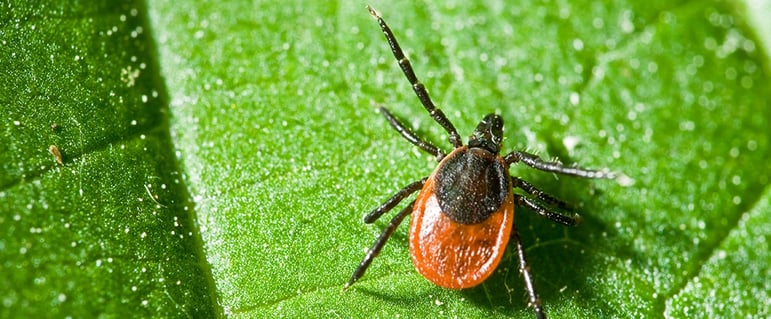As soon as temperatures rise in the late Winter and early Spring, tick populations reactivate. Although some species of ticks are dormant during the cold winter months, they become active earlier than you may think. When temperatures rise above freezing and the snow cover begins to melts, ticks begin to emerge and look for hosts (link to a CDC resource on tick lifecycles, with more resources on disease prevention).
There are three major tick species in New England to look out for: Blacklegged (Deer) Ticks, Dog Ticks (American Dog Ticks, and Brown Dog Ticks), and Lone Star Ticks. The most common tick in New England is the Deer Tick. Deer ticks go through a two-year lifespan, undergoing three stages in their development; larvae, nymph, and adult. Nymph-stage ticks can become active as early as March, or whenever Spring temperatures arrive. Nymph-stage ticks are very small, about the size of a poppy seed.
Why are Ticks Dangerous?
Ticks are sneaky; they feed on our blood and are so tiny they are difficult to see! These qualities make them a nuisance, but what makes them dangerous is the harmful pathogens and diseases they carry. Even though the nymph stage tick resembles a poppy seed in size, their bites can pack a serious disease-infested punch, spreading illnesses such as Lyme disease, Babesioisis, and Anaplasmosis.
Deer Ticks are the main carrier of the bacteria that causes Lyme disease. Depending on the region and season, up to 50% of ticks can be carriers. That's why it's important to be proactive in not only preventing bites with tick spraying, but also knowing how to effectively find and remove them from you, your family, and your pets if bitten.
Here are some tips to steer clear of ticks this spring:
- When walking on a trail or path try to stay in the middle of the trail where it is open to avoid any unwanted contact with lurking ticks.
- After an outing in the outdoors you should always check your body for ticks. Finding and removing a tick quickly can greatly reduce your chances of being infected with a tick-borne disease.
- If you find a tick on you, follow these instructions to remove the tick. Also, learn about 'tick keys', like those we give to our clients (contact us for info on that).
- If possible, try to save the tick in a jar in order to identify the tick and submit it for testing.
- Get an early start on treating your yard with routine, organic tick spray and pest control treatments from Pure Solutions. This will help reduce the population of adult deer ticks that survived the winter, preventing them from laying eggs on your property. Our all natural, organic solution is a tick control spray engineered from eco-friendly botanical oils. It has been proven to be safer for use around kids, pets and the environment, with over 10 years of effective results in mosquito and tick extermination.
Learn More From These Great, Local Resources:
- Tick Encounter
- Department of Health-Vermont
- Mass.gov
- The Center for Disease Control (CDC)
- Umass Amherst Tick Testing
- Georgia Dept. of Public Health
Have any questions, or need help? Let's talk about how Pure Solutions recurring organic tick spray services can make your property safer from deer ticks and the diseases they carry, without harming our beautiful New England environment or endangering the health of your family or pets:




